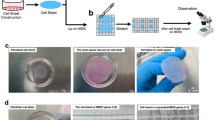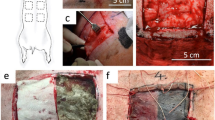Abstract
Autologous skin grafting, the standard treatment for severe burns, is sometimes not possible due to the limited available skin surfaces for the procedure. With advances in tissue engineering, various cell-based skin substitutes have been developed to serve as skin replacements and to promote tissue regeneration and healing. In this work, we propose the use of cell sheet technology to fabricate keratinocyte–fibroblast tissue constructs from the temperature-responsive poly(N-isoproprylacrylamide-co-acrylamide) (PNIAM-co-AM) grafted surfaces for the treatment of burn wounds. The characteristics of the human keratinocyte and fibroblast cell sheets harvested using PNIAM-co-AM grafted surfaces were similar to those cell sheets detached from the commercially-available UpCellTM plates. Upon lowering the incubation temperature, confluent keratinocytes and fibroblasts could be detached as intact sheets, consisting of biologically active cells, as indicated by their high cell viability and their reattachment, migratory, and proliferative activities. A histological analysis of the stratified keratinocyte–fibroblast cell sheets revealed the evidence of cell migration and tissue reorganization to form two distinct epidermal and dermal layers, quite similar to the skin tissue’s structure. In addition, the keratinocyte–fibroblast sheets could synthesize and release significant amounts of essential cytokines and growth factors involved in regulating the wound healing process, including IL-1α, IL-6, TNF-α, VEGF, and bFGF, implying the therapeutic effect of these cell sheets, which could be beneficial to accelerate tissue repair and regeneration, leading to faster wound healing.







Similar content being viewed by others
References
National Burn Repository 2016 Report [database on the Internet]. American Burn Association. 2016. http://www.ameriburn.org/2016%20ABA%20Full.pdf.
Pavoni V, Gianesello L, Paparella L, Buoninsegni LT, Barboni E. Outcome predictors and quality of life of severe burn patients admitted to intensive care unit. Scand J Trauma Resusc Emerg Med. 2010;18:24. https://doi.org/10.1186/1757-7241-18-24.
Brusselaers N, Hoste EA, Monstrey S, Colpaert KE, De Waele JJ, Vandewoude KH, et al. Outcome and changes over time in survival following severe burns from 1985 to 2004. Intensive Care Med. 2005;31:1648–53. https://doi.org/10.1007/s00134-005-2819-6.
Hu ZC, Chen D, Guo D, Liang YY, Zhang J, Zhu JY, et al. Randomized clinical trial of autologous skin cell suspension combined with skin grafting for chronic wounds. Br J Surg. 2015;102:e117–23. https://doi.org/10.1002/bjs.9688.
Sekine H, Shimizu T, Dobashi I, Matsuura K, Hagiwara N, Takahashi M, et al. Cardiac cell sheet transplantation improves damaged heart function via superior cell survival in comparison with dissociated cell injection. Tissue Eng Part A. 2011;17:2973–80. https://doi.org/10.1089/ten.tea.2010.0659.
Halim AS, Khoo TL, Mohd Yussof SJ. Biologic and synthetic skin substitutes: an overview. Indian J Plast Surg. 2010;43:S23–8. https://doi.org/10.4103/0970-0358.70712.
Arno AI, Jeschke MG. The use of dermal substitutes in burn surgery: acute phase. In: Kamolz L-P, Lumenta DB, editors. Dermal replacements in general, burn, and plastic surgery: tissue engineering in clinical practice. Vienna: Springer; 2013. p. 193–210.
Yoshida R, Okano T. Stimuli-responsive hydrogels and their application to functional materials. In: Ottenbrite RM, Park K, Okano T, editors. Biomedical applications of hydrogels handbook. New York, NY: Springer New York; 2010. pp. 19–43.
Matsuda N, Shimizu T, Yamato M, Okano T. Tissue engineering based on cell sheet technology. Adv Mater. 2007;19:3089–99. https://doi.org/10.1002/adma.200701978.
Yamato M, Akiyama Y, Kobayashi J, Yang J, Kikuchi A, Okano T. Temperature-responsive cell culture surfaces for regenerative medicine with cell sheet engineering. Prog Polym Sci. 2007;32:11. https://doi.org/10.1016/j.progpolymsci.2007.06.002.
Wong-In S, KhanhThuyen NT, Siriwatwechakul W, Viravaidya-Pasuwat K. Multilayered mouse preosteoblast MC3T3-E1 sheets harvested from temperature-responsive poly(N-isopropylacrylamide-co-acrylamide) grafted culture surface for cell sheet engineering. J Appl Polym Sci. 2013;129:3061–9. https://doi.org/10.1002/app.39032.
Sakulaue P, Swe AYY, Benchaprathanphorn K, Lertvanithphol T, Viravaidya-Pasuwat K, Siriwatwechakul W. Improving cell detachment from temperature-responsive Poly(N-isopropylacrylamide-co-acrylamide)-grafted culture surfaces by spin coating. ACS Omega. 2018;3:18181–8. https://doi.org/10.1021/acsomega.8b02514.
Aasen T, Izpisua Belmonte JC. Isolation and cultivation of human keratinocytes from skin or plucked hair for the generation of induced pluripotent stem cells. Nat Protoc. 2010;5:371–82. https://doi.org/10.1038/nprot.2009.241.
Sakulaue P, Wong-in S, Viravaidya-Pasuwat K, Siriwatwechakul W. Modification and characterization of Poly(N-isopropylacrylamide-co-acrylamide) grafted tissue culture surface. 2015 4th International Conference on Informatics, Environment, Energy and Applications. IPCBEE. 2015;82:15–9. https://doi.org/10.7763/IPCBEE.2015.V82.3.
Goodpaster T, Legesse-Miller A, Hameed MR, Aisner SC, Randolph-Habecker J, Coller HA. An immunohistochemical method for identifying fibroblasts in formalin-fixed, paraffin-embedded tissue. J Histochem Cytochem. 2008;56:347–58. https://doi.org/10.1369/jhc.7A7287.2007.
Takagi R, Yamato M, Murakami D, Kondo M, Yang J, Ohki T, et al. Preparation of keratinocyte culture medium for the clinical applications of regenerative medicine. J Tissue Eng Regen Med. 2011;5:e63–73. https://doi.org/10.1002/term.337.
Liu L, Yu Y, Hou Y, Chai J, Duan H, Chu W, et al. Human umbilical cord mesenchymal stem cells transplantation promotes cutaneous wound healing of severe burned rats. PLoS ONE. 2014;9:e88348. https://doi.org/10.1371/journal.pone.0088348.
Jubin K, Martin Y, Lawrence-Watt DJ, Sharpe JR. A fully autologous co-culture system utilising non-irradiated autologous fibroblasts to support the expansion of human keratinocytes for clinical use. Cytotechnology. 2011;63:655–62. https://doi.org/10.1007/s10616-011-9382-5.
Werner S, Krieg T, Smola H. Keratinocyte-fibroblast interactions in wound healing. J Investig Dermatol. 2007;127:998–1008. https://doi.org/10.1038/sj.jid.5700786.
Wojtowicz AM, Oliveira S, Carlson MW, Zawadzka A, Rousseau CF, Baksh D. The importance of both fibroblasts and keratinocytes in a bilayered living cellular construct used in wound healing. Wound Repair Regen. 2014;22:246–55. https://doi.org/10.1111/wrr.12154.
Maarof M, Law JX, Chowdhury SR, Khairoji KA, Saim AB, Idrus RB. Secretion of wound healing mediators by single and bi-layer skin substitutes. Cytotechnology. 2016;68:1873–84. https://doi.org/10.1007/s10616-015-9940-3.
Wang Z, Wang Y, Farhangfar F, Zimmer M, Zhang Y. Enhanced keratinocyte proliferation and migration in co-culture with fibroblasts. PLoS ONE. 2012;7:e40951. https://doi.org/10.1371/journal.pone.0040951.
Tang Z, Akiyama Y, Okano T. Temperature-responsive polymer modified surface for cell sheet engineering. Polymers. 2012;4. https://doi.org/10.3390/polym4031478.
Nakao M, Inanaga D, Nagase K, Kanazawa H. Characteristic differences of cell sheets composed of mesenchymal stem cells with different tissue origins. Regen Ther. 2019;11:34–40. https://doi.org/10.1016/j.reth.2019.01.002.
Imaizumi F, Asahina I, Moriyama T, Ishii M, Omura K. Cultured mucosal cell sheet with a double layer of keratinocytes and fibroblasts on a collagen membrane. Tissue Eng. 2004;10:657–64. https://doi.org/10.1089/1076327041348329.
Mendes LF, Pirraco RP, Szymczyk W, Frias AM, Santos TC, Reis RL, et al. Perivascular-like cells contribute to the stability of the vascular network of osteogenic tissue formed from cell sheet-based constructs. PLoS ONE. 2012;7:e41051. https://doi.org/10.1371/journal.pone.0041051.
Kawecki M, Kraut M, Klama-Baryla A, Labus W, Kitala D, Nowak M, et al. Transfer of fibroblast sheets cultured on thermoresponsive dishes with membranes. J Mater Sci Mater Med. 2016;27:111. https://doi.org/10.1007/s10856-016-5718-1.
Kimlin L, Kassis J, Virador V. 3D in vitro tissue models and their potential for drug screening. Expert Opin Drug Discov. 2013;8:1455–66. https://doi.org/10.1517/17460441.2013.852181.
Nagamori E, Ngo TX, Takezawa Y, Saito A, Sawa Y, Shimizu T, et al. Network formation through active migration of human vascular endothelial cells in a multilayered skeletal myoblast sheet. Biomaterials. 2013;34:662–8. https://doi.org/10.1016/j.biomaterials.2012.08.055.
Ngo TX, Nagamori E, Kikuchi T, Shimizu T, Okano T, Taya M, et al. Endothelial cell behavior inside myoblast sheets with different thickness. Biotechnol Lett. 2013;35:1001–8. https://doi.org/10.1007/s10529-013-1174-x.
Koo MA, Lee MH, Kwon BJ, Seon GM, Kim MS, Kim D, et al. Exogenous ROS-induced cell sheet transfer based on hematoporphyrin-polyketone film via a one-step process. Biomaterials. 2018;161:47–56. https://doi.org/10.1016/j.biomaterials.2018.01.030.
Koo MA, Hee Hong S, Hee Lee M, Kwon BJ, Mi Seon G, Sung Kim M, et al. Effective stacking and transplantation of stem cell sheets using exogenous ROS-producing film for accelerated wound healing. Acta Biomater. 2019. https://doi.org/10.1016/j.actbio.2019.01.019.
Auger FA, Lacroix D, Germain L. Skin substitutes and wound healing. Skin Pharmacol Physiol. 2009;22:94–102. https://doi.org/10.1159/000178868.
Seeger MA, Paller AS. The roles of growth factors in keratinocyte migration. Adv Wound Care. 2015;4:213–24. https://doi.org/10.1089/wound.2014.0540.
Woodley DT, Wysong A, DeClerck B, Chen M, Li W. Keratinocyte migration and a hypothetical new role for extracellular heat shock protein 90 alpha in orchestrating skin wound healing. Adv Wound Care. 2015;4:203–12. https://doi.org/10.1089/wound.2014.0566.
Schultz GS, Davidson JM, Kirsner RS, Bornstein P, Herman IM. Dynamic reciprocity in the wound microenvironment. Wound Repair Regen. 2011;19:134–48. https://doi.org/10.1111/j.1524-475X.2011.00673.x.
Pastar I, Stojadinovic O, Yin NC, Ramirez H, Nusbaum AG, Sawaya A, et al. Epithelialization in wound healing: a comprehensive review. Adv Wound Care. 2014;3:445–64. https://doi.org/10.1089/wound.2013.0473.
Maas-Szabowski N, Stark H-J, Fusenig NE. Keratinocyte growth regulation in defined organotypic cultures through IL-1-induced keratinocyte growth factor expression in resting fibroblasts. J Investig Dermatol. 2000;114:1075–84. https://doi.org/10.1046/j.1523-1747.2000.00987.x.
Fahey E, Doyle SL. IL-1 family cytokine regulation of vascular permeability and angiogenesis. Front Immunol. 2019;10:1426. https://doi.org/10.3389/fimmu.2019.01426.
Parameswaran N, Patial S. Tumor necrosis factor-α signaling in macrophages. Crit Rev Eukaryot Gene Expr. 2010;20:87–103. https://doi.org/10.1615/critreveukargeneexpr.v20.i2.10.
Köck A, Schwarz T, Kirnbauer R, Urbanski A, Perry P, Ansel JC, et al. Human keratinocytes are a source for tumor necrosis factor alpha: evidence for synthesis and release upon stimulation with endotoxin or ultraviolet light. J. Experi. Med. 1990;172:1609–14.
Acknowledgements
This work was financially supported by Petchara Pra Jom Klao Doctoral Scholarship, King Mongkut’s University of Technology Thonburi (KMUTT), and Innovation Hub-Ageing Society: Translational Research (TR068), Council of University Presidents of Thailand.
Author contributions
KB carried out and analyzed all the experimental work in this study. She also wrote the paper with support from KVP, WS, and KC. PS and WS developed a method and fabricated the PNIAM-co-AM grafted surfaces. PM and KC provided human skin samples for this study and useful comments to help develop tissue-engineered skin equivalents. KVP supervised the work and approved the final draft.
Author information
Authors and Affiliations
Corresponding author
Ethics declarations
Conflict of interest
The authors declare that they have no conflict of interest.
Additional information
Publisher’s note Springer Nature remains neutral with regard to jurisdictional claims in published maps and institutional affiliations.
Supplementary information
Rights and permissions
About this article
Cite this article
Benchaprathanphorn, K., Sakulaue, P., Siriwatwechakul, W. et al. Preparation and characterization of human keratinocyte–fibroblast cell sheets constructed using PNIAM-co-AM grafted surfaces for burn wound healing. J Mater Sci: Mater Med 31, 126 (2020). https://doi.org/10.1007/s10856-020-06469-4
Received:
Accepted:
Published:
DOI: https://doi.org/10.1007/s10856-020-06469-4




